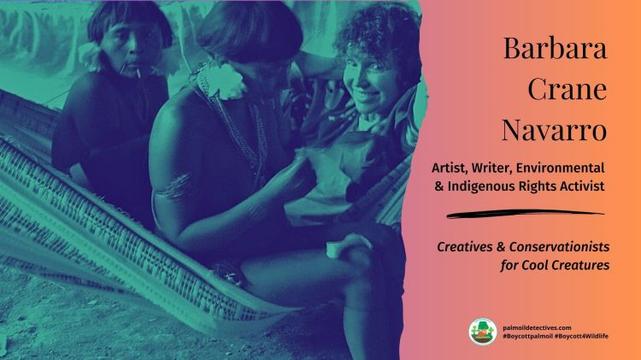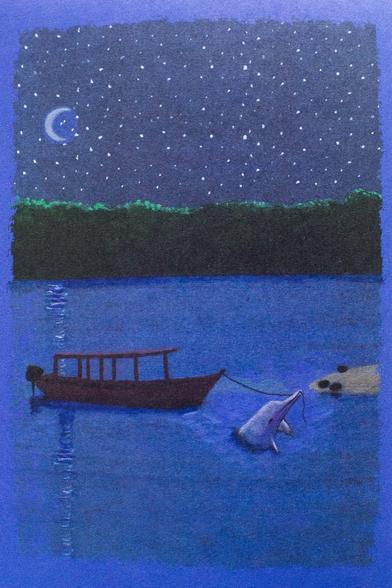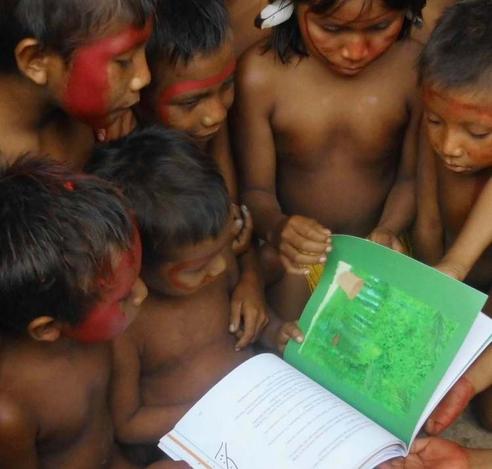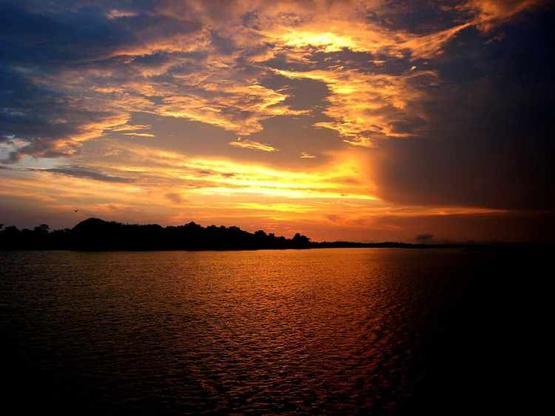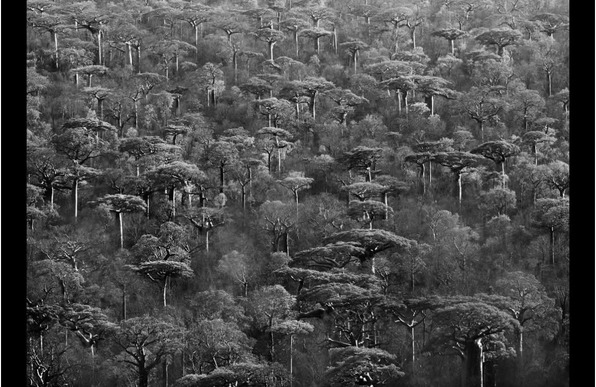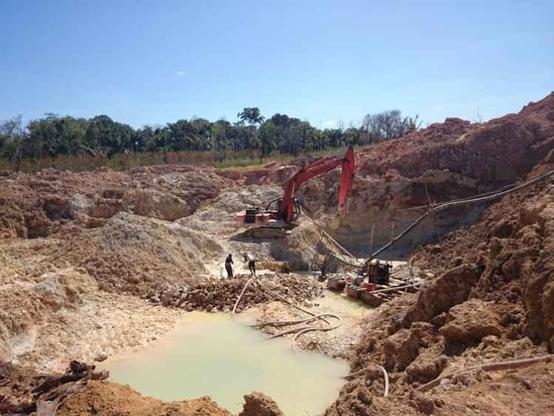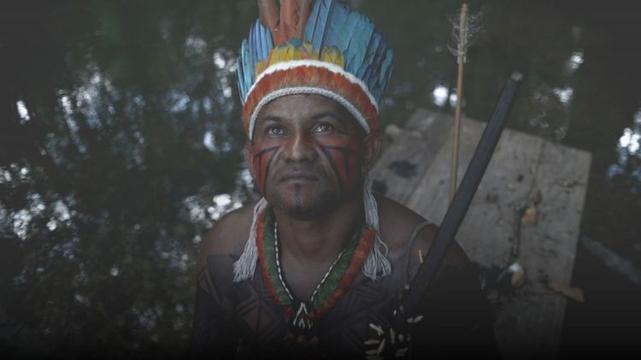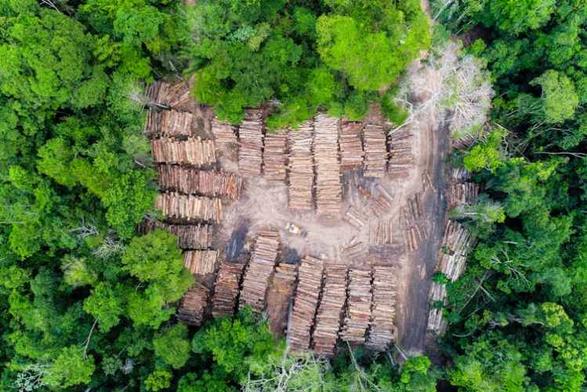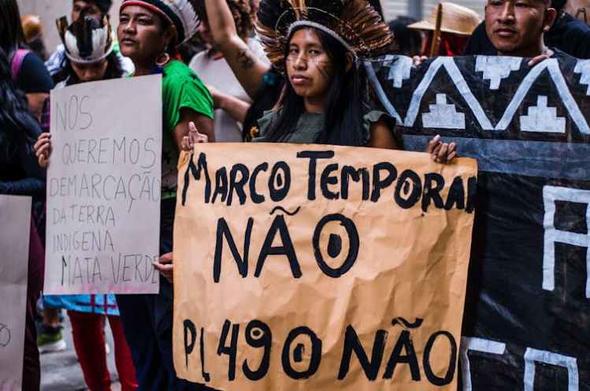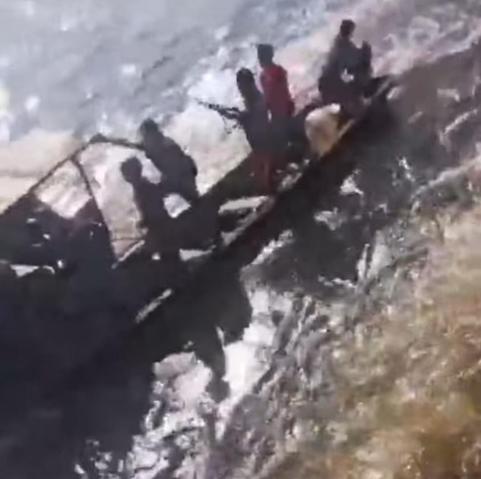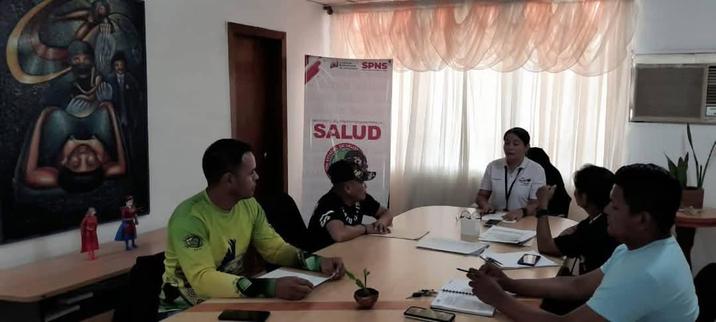Artist and Indigenous Rights Advocate Barbara Crane Navarro
Barbara Crane Navarro: In Her Own Words
Artist, Writer, Environmental & Indigenous Rights Activist
Bio: Barbara Crane Navarro
Barbara Crane Navarro is a French-American artist, writer, Indigenous and animal activist who lives near Paris. From 1968 to 1973 she studied at Rhode Island School of Design, then she went on to study at the San Francisco Art Institute in San Francisco, California, for a BFA.
Her work over many decades has been informed and inspired by time spent with indigenous communities. She took various study trips devoted to the exploration of techniques and natural pigments of different indigenous communities including the Dogon of Mali, West Africa, and the Yanomami communities in Venezuela and Brazil.
Over many years, during the winters, she studied the techniques of traditional Bogolan painting. Hand woven fabric is dyed with boiled bark from the Wolo tree or crushed leaves from other trees, then painted with mud from the Niger river which oxidizes in contact with the dye. Through the Dogon and the Yanomami, her interest in the multiplicity of techniques and supports for aesthetic expression influenced her artistic practice.
Her voyages to the Amazon Rainforest have informed several series of paintings created while living among the Yanomami. The support used is roughly woven canvas prepared with acrylic medium then textured with a mixture of sand from the river bank and lava. This supple canvas is then rolled and transported on expeditions into the forest. These are then painted using a mixture of acrylic colors and Achiote and Genipap, the vegetal pigments used by the Yanomami for their ritual body paintings and on practical and shamanic implements. Barbara is deeply concerned about the ongoing devastation of the Amazon Rainforest and this has inspired many of her films, installation projects and children’s books.
Palm Oil Detectives is honoured to interview to Barbara Crane Navarro about her fascinating work, indigenous activism, the devastation of deforestation and land-grabbing from gold mining on the Indigenous Yanomami people
Great Green Macaw Ara ambiguusBehind the insatiable appetite for buying #gold is a dark secret of money laundering, illegal #mining, #ecocide, sex #slavery and human misery for the #Yanomami people of #Venezuela & #Brazil. @BarbaraNavarro #BoycottGold4Yanomami
Read more: Illegal gold mining and the Yanomami’s fight for their land
‘Illegal mining in the Amazon hits record high amid Indigenous protests’, Jeff Tollerson, Nature 2021.
FinCEN Files investigations into the gold trade from around the world. Kyra Guerny, International Consortium of Investigative Journalists, 2020.
Five Golden Rings and an Environmental Dilemma, Wake Forest University, 2018.
‘Gold mining leaves deforested Amazon land barren for years, find scientists’ The Conversation, July 1, 2020.
Mercury: Chasing the Quicksilver by InfoAmazonia
‘Pictures from outer space reveal the extent of illegal gold mining in Peru’, The Conversation, May 7, 2021.
‘Sex trafficking ‘staggering’ in illegal Latin American gold mines: researchers’, Reuters, 2016.
Yanomami: Povos Indigenas Brasil
Help Barbara’s movement to #BoycottGold4Yanomami
1. By regularly sharing out these tweets below…
2. By following the #BoycottGold4Yanomami hashtag on Twitter and share out other people’s tweets
“I wrote Rainforest Magic, children’s stories about Yanomami children Namowë and Meromi to honour the Yanomami families I love and to raise awareness of the disappearing Amazon” #BoycottGold4Yanomami @BarbaraNavarro
It’s important that consumers know – every item we buy affects the lives of people and animals. #Gold #mining and #palmoil directly impacts Indigenous peoples. #Boycottpalmoil #BoycottGold4Yanomami #Boycott4Wildlife @BarbaraNavarro
#Yanomami children as young as 12 are forced into prostitution for illegal miners that take over their rainforest home for gold mining. Fight back against this with your wallet and refuse to buy gold! #BoycottGold4Yanomami @BarbaraNavarro
Top Brazil gold exporter leaves a trail of criminal probes and illegal mines! Please #Boycott4Wildlife #BoycottGold4Yanomami! @ScarpullaA @barbaranavarro https://news.mongabay.com/2021/11/top-brazil-gold-exporter-leaves-a-trail-of-criminal-probes-and-illegal-mines/ via @Mongabay
Tweet thisL’amico a sorpresa del ragazzo Yanomami nella giungla! #BoycottGold4Yanomami #Boycott4Wildlife @ScarpullaA @barbaranavarro https://barbara-navarro.com/2021/12/24/ital-dec-24-lamico-a-sorpresa-del-ragazzo-yanomami-nella-giungla/
Tweet thisAmigo surpresa do menino Yanomami na selva! #BoycottGold4Yanomami #Boycott4Wildlife @barbaranavarro @ScarpullaA https://barbara-navarro.com/2021/12/23/amigo-surpresa-do-menino-yanomami-na-selva/
Tweet thisThe Art of #Greenwashing by Luxury Merchants of the Death #BoycottGold4Yanomami #Boycott4Wildlife @barbaranavarro @ScarpullaA https://barbara-navarro.com/2020/12/07/the-art-of-greenwashing-by-the-luxury-merchants-of-the-death-of-nature-and-indigenous-peoples-in-their-own-words-the-people-of-gold-and/
Tweet this#Indigenous knowledge could be the answer to stopping #Climate Change! #ClimateEmergency @ScarpullaA @barbaranavarro #Boycott4Wildlife and #BoycottGold4Yanomami and save the forests, animals and indigenous peoples of South America! https://barbara-navarro.com/2021/12/25/indigenous-knowledge-could-be-the-answer-to-climate-change-the-st-andrews-economist/
Tweet thisAmigo surpresa do menino Yanomami na selva! Boicote todos os produtos resultantes do desmatamento; ouro, óleo de palma, carne, soja, madeiras exóticas, pedras preciosas #BoycottGold4Yanomami #Boycottpalmoil #Boycott4Wildlife @BarbaraNavarro @ScarpullaA https://barbara-navarro.com/2021/12/23/amigo-surpresa-do-menino-yanomami-na-selva/
Tweet this@Cartier Foundation uses #greenwashing “art” to sell their business model as eco-friendly. This is #greenwashing! #Yanomami people and #animals are dying for #gold! @BarbaraNavarro @ScarpullaA #BoycottGold4Yanomami #Boycott4Wildlife https://barbara-navarro.com/2020/10/11/the-cartier-foundation-epitomizes-the-insidious-practice-of-using-an-art-foundation-to-seduce-the-public-into-believing-that-its-merchandise-and-business-model-is-actually-the-opposite-of-its-true/
Tweet thisMy Exhibition “Pas de Cartier: Yanomami and Trees” Gold mining by @Cartier @Bulgariofficial and COVID-19 are killing the #Yanomami people. This is why we #BoycottGold4Yanomami @BarbaraNavarro @ScarpullaA https://barbara-navarro.com/2020/08/04/exhibition-pas-de-cartier-yanomami-and-trees-gold-mining-and-gold-luxury-items-covid-19-propagated-by-gold-miners/
Tweet this“When you cut down the trees, you assault the spirits of our ancestors. When you dig for minerals you impale the heart of the Earth” Cacique Raoni Metuktire Illegal gold mining is why we #BoycottGold4Yanomami #Boycott4Wildlife @BarbaraNavarro @ScarpullaA https://barbara-navarro.com/2020/06/27/gold-fever-covid-19-and-the-genocide-of-the-yanomami-update/
Tweet this
“In the Venezuelan and Brazilian Amazon, I witnessed the destruction of nature from deforestation and gold mining worsen as I returned year after year”
Barbara Crane Navarro
The Yanomami communities I spent time with were very worried about this situation and the shamans worked to fight against it, but this has been in vain so far.
Since my birth, I was always an artist and spent my childhood drawing and painting
I want to understand why people in indigenous societies spend so much time and effort creating art and with such an incredible variety of supports and substances.
“Since 2005, I’ve created a performance and film project: Fire Sculpture, to bring urgent attention to rainforest destruction. And to protest against the continuing destruction of the Yanomami’s territory. I’ve publicly set fire to my totemic sculptures. These burning sculptures symbolise the degradation of nature and the annihilation of indigenous cultures that depend on the forest for their survival.”
~ Barbara Crane Navarro
The idea of burning the sculptures was to make a symbolic point about how Yanomami and other indigenous communities are endangered by our consumerism which creates chaos and destruction where they live, in their ancestral home.
I wrote Amazon Rainforest Magic, two stories of Yanomami children Namowë, a Yanomami boy and Meromi, a Yanomami girl in honour of the families I know and love
Several of the Yanomami children and their families I know well are among the characters in the two books of the series.
I self-published my books with CreateSpace years ago which was subsequently bought by Amazon’s KDP. Now my books are only available on Amazon or here at my gallery near Paris, where my artwork is also available.
The two books are available from Barbara Crane Navarro’s Amazon page in English, Spanish and French.
Buy Vol. 1 Buy Vol. 2“Amazon Rainforest Magic” presents a world that at first might seem whimsical, where people, animals, and plants joke, conspire, and argue with each other. The serious point is that humans are no more important than any of the other creatures – all are mutually dependent, some are just more aware of it than others.
The plants and the animals, each with special knowledge, accompany the hero, Namowë, as he embarks on a life-saving quest for a cure for his ailing youngest sister. When he embarks on this exciting journey through the jungle, he has already taken a big step toward maturity.
Behind the charming artwork and story is a clear message that we humans are not separate from our environment and that to put ourselves above nature is arbitrary and ultimately counter-productive.
Illustration by Barbara Crane Navarro from her book “Amazon Rainforest Magic – The adventures of Meromi, a Yanomami girlAll of the various indigenous communities along the rivers in the Amazon are very alarmed at the acceleration of the devastation of the forests.
https://www.youtube.com/watch?v=yd3GoL5MeAg
“I discovered that much of the Yanomami’s art is about venerating nature and the spirits of the forests, sky, water and the animals.”
~ Barbara Crane-Navarro
Tundra project/Nature Morte
The repercussions of the 2019 fires in the Amazon and Arctic regions continue to impact forests, water, the atmosphere and indigenous communities. This art is an artistic dialogue between two territories and two geomorphologies. Each have a planetary resonance.
It’s important consumers know that every shopping choice we make has repercussions on the lives of people in other parts of the world
I try to eat only local and in-season vegetables grown nearby. What I grow myself I keep as jam and conserve to eat in the winter months.
Many different indigenous communities in the nine countries of the Amazon region are devastated by gold mining with its resulting deforestation, violence against indigenous peoples, mercury poisoning and Covid-19 propagated by gold miners.
Amazonian gold minehttps://twitter.com/PersonalEscrito/status/1432750926004170755?s=20
https://twitter.com/BarbaraNavarro/status/1350098960954892288?s=20
https://twitter.com/PattyLaya/status/1161291783084621827?s=20
Merchants of Gold, Greed and Genocide
Hunger for Gold in the Global North is fuelling a living hell in the Global South
Here are 13 reasons why you should #BoycottGold4Yanomami
Image: ‘llegal gold that undermines forests and lives in the Amazon’ by Igarapé Institute
Behind the insatiable appetite for #gold is a dark secret of money laundering, illegal #mining, environmental damage and human misery. #BoycottGold4Yanomami @BarbaraNavarro
1. Gold mining = greenwashing of crime and corruption
2. Even the world’s biggest gold-importing nations don’t properly monitor the origins of their gold
3. Laundering crimes using gold is easy
4. Gold is a legal version of cocaine
5. Gold mining causes massive deforestation
6. Indigenous people have no rights
7. Brazil’s racist President, Bolsonaro allows land-grabbing to continue
8. Indigenous women and children are forced into sex slavery
9. Violence and murder in gold mining is common
10. Mercury kills ecosystems, people and animals
11. Ecosystems rarely recover from the damage – they are dead
12. Jewellery and electronics companies and criminals are the only ones who benefit from gold
13. Over a million children are forced to work in gold mines
Forests and rivers are a spiritual and practical necessity for Indigenous people
However their access to food and water is removed by palm oil and soy plantations, cattle grazing and gold mining, which contaminates the water and kills the fish. Forest wildfires are happening in the Amazon due to degraded and destroyed forests and rivers.
Deforestation by fire for palm oilDeforestation by Sean Weston https://seanweston.co.ukDirty Gold War: A documentary about gold mining
The gold industry is overflowing with corruption:
If there’s a crackdown in Peru, you just smuggle the gold across the border to Chile. Or if there’s a crackdown all across Latin America, then you can simply sell your gold through the Emirates, where there are very few controls. It’s a very difficult industry to completely eliminate the opportunities for money laundering, because it’s so global and you can just keep shifting your business.
‘‘Dirty Gold’ chases ‘three amigos’ from Miami to Peru and beyond’:
International Consortium of Investigative Journalists
Nobody needs to use gold jewelry or watches to decorate themselves. There are so many less destructive and non-destructive options. Small elements of gold are in phones and other electronic items. We should replace them as seldom as possible.
Barbara Crane Navarro
We all need to boycott palm oil, soy, meat, exotic wood, gold and any other product of deforestation.
The #Boycott4Wildlife movement has the same goals as the #BoycottGold4Yanomami movement
Indigenous peoples know that their well-being depends on healthy forests and ecosystems. They see the evidence of that truth around them every day.
Mining incursions in the Amazon jungle. Maned Three-toed Sloth Bradypus torquatusThe Dolphin and the gold miners’ boat at twilight, from my children’s book series- Amazon Rainforest Magic, the adventures of Meromi, a Yanomami girlThe future well-being of people in the West will be determined by how soon we realise that we must respect nature and not take more than we need, just as indigenous peoples do.
“If we continue to treat nature as a commodity, all the living world, including us, will suffer”
~ Barbara Crane Navarro
Every effort, even the smallest effort, is important
I can’t predict the outcome, but I believe that we have to fight every day in order to mitigate the damage we’re doing.
Did you know that #gold #mining #palmoil and cattle grazing is destroying the last great swathes of the Amazon jungle? This land belongs to #Indigenous people! So #BoycottGold4Yanomami and #Boycottpalmoil @BarbaraNavarro
“I was born in 1950 and we are no longer living in the world that I knew when I was young”
I was 20 when humans began using more resources every year than the earth could replenish.
~ Barbara Crane Navarro
“It has been heart wrenching to witness the decline of nature
and to grieve for what has disappeared.”
Barbara Crane Navarro
[Before] The pristine Amazon rainforest. [After] Absolute devastation following gold mining in the Yanomami territory at the border of Venezuela and Brazil.
There are many rainforest animals that I love that make the Amazon rainforest absolutely enchanting. The monkeys, pink river dolphins, giant river otters, capybaras, tapirs, macaws and so many birds and butterflies are some of my favourites.
Here are a few of the 1000’s of animals disappearing forever due to out-of-control extractive mining, palm oil and meat deforestation in the Amazon jungle
Blonde Capuchin Sapajus flavius
Savage’s Glass Frog Centrolene savagei
Brazilian three-banded armadillo Tolypeutes tricinctus
Orange-breasted Falcon Falco deiroleucus
Glaucous Macaw Anodorhynchus glaucus
Nancy Ma’s Night Monkey Aotus nancymaae
Maned Wolf Chrysocyon brachyurus
Andean Mountain Cat Leopardus jacobita
Marsh Deer Blastocerus dichotomus
Alta Floresta titi monkey Plecturocebus grovesi
Colombian Red Howler Monkey Alouatta seniculus
Northern Muriqui Brachyteles hypoxanthus
Brown Howler Monkey Alouatta guariba
Andean Night Monkey Aotus miconax
Spiny-headed Tree Frog Triprion spinosus
White-Nosed Saki Chiropotes albinasus
Amazon River Dolphin Inia geoffrensis
Buffy-tufted-ear Marmoset Callithrix aurita
Spectacled Bear Tremarctos ornatus
If you want to make a difference to the lives of Indigenous people in the Amazon, there are some NGOs to avoid, and others that are really making a difference…
Some NGOS such as Survival claim to be helping indigenous people are great pretenders. They spread awareness but don’t offer practical on the ground support for people like the Yanomami.
These NGOS that allegedly work for Indigenous Rights simply lobby to governments to recognise indigenous land rights. They write and talk about issues affecting Indigenous peoples without having any real, tangible impact.
I donate as often as possible to a Brazilian NGO, APIB: The Articulation of Indigenous Peoples of Brazil.
APIB on the other hand are taking the Brazilian government to court! They have an emergency campaign now concerning gold mining, deforestation and Covid.
Please donate to APIB:
With the funds they will take the Brazilian government to court for this disgraceful ecocide and genocide!
Donate Help the Yanomami
Photography, Art: Barbara Crane Navarro, PxFuel, Creative Commons, Wikipedia, Greenpeace, Sean Weston, Igarapé Institute.
Words: Barbara Crane Navarro
I welcome you to connect with me, you can find me here on Twitter @BarbaraNavarro
https://twitter.com/BarbaraNavarro/status/1457330048181186564?s=20
https://twitter.com/BarbaraNavarro/status/1429423517070766086?s=20
https://twitter.com/BarbaraNavarro/status/1463827100738236420?s=20
https://twitter.com/BarbaraNavarro/status/1445658455713349632?s=20
Buy vintage jewellery instead
Find out moreImage: ‘llegal gold that undermines forests and lives in the Amazon’ by Igarapé Institute
#Amazon #animals #art #BarbaraCraneNavarro #Boycott4wildlife #BoycottGold4Yanomami #BoycottPalmOil #Brazil #Christmas #Climate #ClimateEmergency #corruption #CreativesForCoolCreatures #deforestation #ecocide #gold #goldMining #greenwashing #indigenous #IndigenousActivism #indigenousRights #investigativeJournalism #jewellery #mining #palmoil #rainforestConservation #slavery #Valentine #Venezuela #Yanomami
